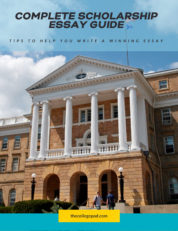There are four types of financial aid available to help you pay for college: grants, loans, scholarships and work-study. These funds are available through the federal government, state, colleges and private organizations. How you pay for college will depend on your eligibility for these different types of aid.
To access financial aid, you must first submit a Free Application for Federal Student Aid (FAFSA). This application becomes available in October of your senior year of high school. After you submit the FAFSA, you will receive a Student Aid Report that will have your Expected Family Contribution – a number that will be used by colleges to calculate your eligibility for financial aid.
In addition to the FAFSA, some private colleges might ask you to submit the CSS PROFILE. This financial aid application is used by approximately 250 private colleges to award institutional (college) funds.
It is also important to remember that some financial aid is available on a first-come, first-served basis. The sooner you submit the FAFSA, the more money you will be able to access. For example, federal work-study and Federal Supplemental Educational Opportunity Grants (FSEOG) are two pots of fund awarded this way.
>> RELATED POST: Financial Aid Guide
Here is some detailed information for each type of financial aid available:
1. Grants
There are a number of grants available to help you pay for college. Grants come from various sources, including the state and federal government, and the college itself. A grant is considered gift aid, which means it does not have to be repaid. Some types of federal grants are as follow:
- Federal Pell Grant
- Federal Supplemental Educational Opportunity Grants (FSEOG)
- TEACH Grant
- Iraq & Afghanistan Service Grants
2. Scholarships
Scholarship is another way to pay for college. They are considered a gift aid and awarded by colleges or private organizations. Actually, the largest source of scholarships is colleges. Scholarships can be awarded either on merit (for e.g., GPA, ACT/SAT scores, or special talent) or based on a student’s financial need. Some scholarships that are considered need-based aid could still have a minimum GPA requirement.
You do not have to wait until you are applying to college to start applying for scholarships. Many private scholarships are available to students in 8th grade.
To begin your scholarships search, there are a few things to keep in mind – never pay for a scholarship and stay away from sources that are not reputable. Visit our scholarship search page to begin your search.
>>Related Post: 7 of the Biggest Scholarships you Can Win
3. Student Loans
Student Loans are considered self-help financial aid that has to be repaid. Most financial aid awards will contain some loans. Some of the loans available to students (and parents) come from the federal government or banks. Federal student loans tend to have better interest rates and repayment terms.
Below are the different types of federal loans available to undergraduate students and parents:
- Subsidized loans are available to students who demonstrate financial need. While students are in college, the federal government pays the interest on the loans. Upon graduation, students must begin repaying the loan with interest.
- Unsubsidized loans are available for all students. The difference between this loan and subsidized loan is the government does not pay the interest for an unsubsidized loan. However, students have the option to pay the interest while in college (the recommended option); or allow the interest to accrue while in college, and then start paying back both the accrued and the principal after graduation (not recommended).
- Parent Plus Loans are available to parents of undergraduate dependent students. Parents are required to pass a credit check to qualify for these loans. If a parent cannot qualify for Parent Plus Loan because of poor credit, the student then becomes eligible for additional subsidized loans.
4. Work-Study
Another source of financial aid is work-study. It is awarded as part of financial aid to part-time and full-time undergraduate who qualify. Work-study allows students them to gain valuable work experience and earn income at the same time. The jobs are available on campus and, in some cases, off-campus. Work-study jobs are not guaranteed; you must apply for these positions.
Final Thoughts
Remember, going to college is quite expensive, but there are many sources of financial aid available to help you fund your education. The first step you must take to access any of these funds (with the exception of private scholarships) is complete the FAFSA.



